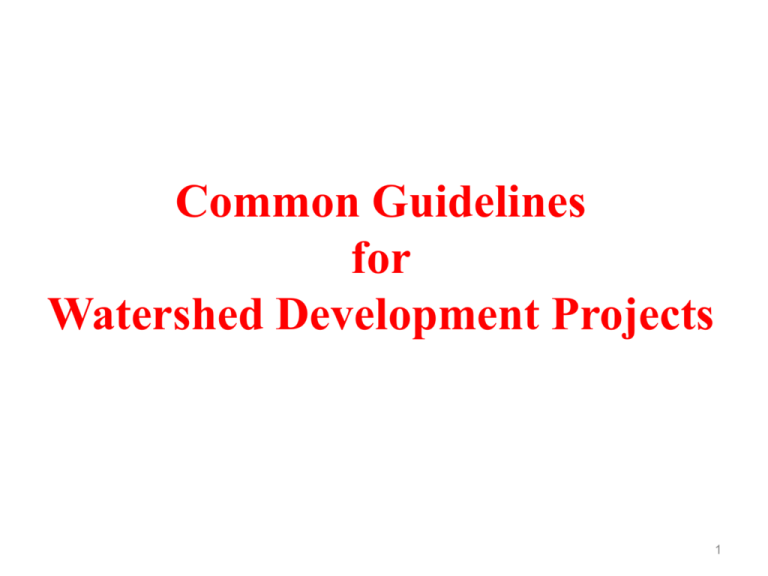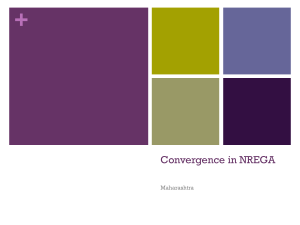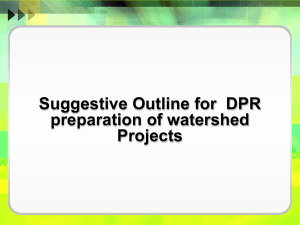Common Guidelines for Watershed Development projects
advertisement

Common Guidelines for Watershed Development Projects 1 Rainfed Agriculture • About 60% of net-sown area of India & 82% of the world is rainfed. • Rainfed area support 40% of population, 66% livestock and contribute 40% to the food production. • About 87% area of pulses and minor millets, 77% oil seeds, 66% cotton & 50% cereals are rain dependent. • 100% of forest and grazing lands, 80% of apples, mangoes and temperate fruits are un-irrigated. • Seed spices, herbals, guar gum and other special attribute crops are unique for the rainfed area. 2 Fig.1 Comparative growth (%) in the Net State Domestic Product in more than 40% irrigated and more than 60% rainfed agricutlure 5 4.01 (rainfed) 4 3 2.9 2.07 2 irrigated irrigated 1 0 -0.14 (rainfed) -1 1985-1995 1996- 2004 3 Rainfed Agriculture & Watershed Management • Rainfed agriculture is complex, diverse, under invested, risky, vulnerable and distress prone. • Due to climatic changes, frequency of extreme weather events like droughts has increased during past 15 years. • Watershed management is the best option for integrated management of resources to alleviate poverty, hunger and distress. • Common Guidelines for convergence, coordination and harmonization of development projects were necessary. 4 Commonalities among the past guidelines. S. No Item 1 National level schemes/program 2 Watershed approach 3 Institutions MoA MoRD MoE&F NWDPRA & other DDP, DPAP, IWDP NAP Yes Yes Yes i. PIA i. PIA i. JFMC ii. WA/ WC ii. WA/ WC ii. FDA 4 Registration under Societies Act Yes Yes Yes (except JFCM)* 5 All adult members constitute General body of WA Yes Yes Yes 6 Joint Operation of A/C Yes Yes Yes 7 Overhead/Administrative cost in %age 10 10 10 8 Contributions or sharamdan Corpus fund WDF VDF *JFMCs are registered with territorial or wildlife DFO. 5 What is New & Innovative ? • The new guidelines have been built on the past 14 years of experience of all the stakeholder Ministries. • Internalises the new policies, economic reforms, programmes, schemes and paradigms. • Role of the Panchayati Raj Institutions and NGO’s has been addressed adequately. • Foreclosure of the projects introduced. • Emphasizes, convergence, integration of natural resource management, productivity, livelihood and income. Farming system, micro-enterprising, unique activities for landless, assestless, small and marginal farmers. • Allocation of funds to states, districts and selection of projects made objective. 6 Key Features • Delegating powers to the States for sanctioning and implementation of projects. • Dedicated institutions of multi-disciplinary professionals at national, state and district level. • Strengthening of institutions at national, state and district level to ensure professionalism. • Project duration has been made flexible into 3 distinct phases to expand the scope. • Livelihoods have been focused through integrated farming systems. 7 • Clustering of small watershed in the range of 1000-5000 ha areas to optimize transaction cost. • Scientific planning and capacity building for innovative new paradigms. • Multi tier Ridge to valley implementation with inter departmental coordination and net working emphasized. In many cases Forest Department has to play major role. 8 Guiding Principles • Equity and gender inclusiveness. • Centrality of community and stakeholders participation. • Transparency through operating of joint accounts. • Facilitating agencies for social mobilisation, community organisation proposed. • Role of VO has been defined. • Capacity building for new technological inputs. • Monitoring, evaluation and learning. 9 Organization of development is process based National Level Local Level NRM, Income & employment generation State Level District Level Emphasis on decentralization 10 Institutional Arrangements at National Level • Role of NRAA has been defined. • Institutional arrangements at the Ministerial level and their roles are illustrated. • Responsibilities for approving projects transferred to the States. • Matters related with policies, perspective planning, allocation of budget, monitoring & evaluation strengthened. • Direct remittance of funds to dedicated accounts. • A National Data Centre and portal provided. 11 Institutional Arrangements at State Level • A dedicated mechanism of State Level Nodal Agency (SLNA) is proposed wherever necessary. • SLNA will be chaired by the Development Commissioner/Addl. Chief Secretary/Agricultural Production Commissioner/Principal Secretary of the concerned Department or equivalent rank. • SLNA will be represented by all concerned Departments of the State, one representative from the Central Nodal Ministry, NRAA, VO and professional experts. 12 Major Functions of SLNA • The main function of the SLNA will be to prepare perspective and strategic plans. • Approve PIA, projects and evaluators etc. • Sanction projects according to perspective and strategic plans. • Provide support to District Watershed Development Unit (DWDU). 13 Institutional Arrangements at District level • If the project area is more than 25,000 ha, a dedicated District Watershed Development Unit (DWDU) will be set up. • If the area is less than 25,000 ha the existing arrangements will be followed. • DWDU will coordinate with District Planning Committee for convergence. • DWDU will have multi-disciplinary professionals. 14 Major Functions of DWDU • Identify potential PIA & recommend to SLNA. • Prepare strategic plans for watershed development projects. • Provide professional/ technical support to PIA and many other functions. • Facilitate coordination with relevant programmes/ schemes and many other functions. 15 Institutional Arrangements at Project Level • The project implementing agency will be selected on the basis of definite criteria. • The implementing agency will constitute a multi- disciplinary professional Watershed Development Team (WDT). • Watershed Committee with elected/ nominated Chairman by Gramsabha. • Self-Help Group amongst poor, landless, small and marginal farmers. • User group around activities. • A joint account will be operated by Secretary of Watershed Committee and WDT nominee as a measure of transparency. • The project will be implemented in 3 distinct phases. 16 Role of Panchayati Raj Institutions • The District Planning Committee will provide governance support to the programme. • The District Panchayat/ Zila Parishad and Intermediary Panchayats will have important role in matters relating to coordination, review of progress, settling disputes and foreclosing of the projects. • The gram sabha will enable democratic process. • The gram sabha will supervise Watershed Committee, authenticate accounts/ expenditure, facilitate convergence, maintain assets register and allocate usufructs. 17 Allocation of Funds • Nodal Ministry/Department Will allocate budgetary outlay for projects among the States based on past performance, State’s perspective Plan, percentage of rainfed area & wastelands/ degraded lands. • SLNA will distribute funds to districts based on perspective Plan, and percentage of rainfed area & wasteland/degraded lands/Panchayat lands. • States will sanction their Projects within the state allocation. • Nodal Ministry will release funds for on going and newly sanctioned project to the states. 18 Budget component % of the Budget Project Management: - Administrative costs - Monitoring - Evaluation 10 1 1 Preparatory phase, including: - Entry point activities, - Institution and capacity building - Detailed Project Report (DPR) 4 5 1 Watershed Works Phase: - Watershed development works, - Livelihood activities for the asset less persons, - Production system and micro enterprises. Consolidation phase 50 10 Equity 13 5 Total 100 19 Other Key Components • Watershed Development or corpus Fund through contributions. • Farming systems for efficient use of inputs and natural resources. • Capacity building. • Revision of financial norms is under consideration. 20 Comparison of Hariyali, 2003 and Common Guidelines, 2008 S. No. Contents Hariyali Guidelines, 2003 Common Guidelines, 2008 1 Programmes Three programmes IWDP, Single Programme IWMP DPAP, DDP 2 Project Area One micro-watershed (500 A cluster of microha average size) watersheds (1000 ha to 5000 ha) 3 Selection of Project area did not Assured irrigation area watershed exclude assured irrigation excluded from project area area 4 Cost per ha. Rs. 6,000 Rs. 12,000- 15000(proposed) 5. Project Period 5 years 4 to 7 years 6 Number of Five (15%, 30%, 30%, Three (20%, 50%, 30%) Installments 15%, 10%) Cntd…… 21 S. No. Contents Hariyali Guidelines, 2003 Common Guidelines, 2008 7 Fund Allocation Training & Comm. Mobi. 5% Training 5% Admn. 10% Admn. 10% Mon. & Eval. 2% Works 85% Works 78% Consolidation 5% 8 Institutional Support Weak Institutional arrangements 9 Role of States Only advisory and Sanctioning authority for supervisory with no budget projects with funding support support for monitoring 10 PIA at Project Line Departments/ level Autonomous Body/ PRI Dedicated Institutional Structures at National, District, Project and Village level Line Departments/ Autonomous Body/ VO 22 S. No. Contents Hariyali Guidelines, 2003 Common Guidelines, 2008 11 PIA at Village Gram Panchayat level Watershed Committee 12 Training 2.5% of project funds 5% of project funds 13 Planning No separate component 1% for DPR Preparation with scientific inputs 14 Monitoring & Evaluation No separate component Mid-term & final evaluation 2% of project cost Concurrent & Post Project evaluation including evaluation of DPR 15 Sustainability Weak mechanism with WDF Consolidation Phase with WDF as a tool and livelihood component as a tool 16 Foreclosure Not provided Provided 17 Central Share and State Share 75:25 for DPAP and DDP 11:1 for IWDP 90:10 for IWMP 23 Part - II Convergence 24 CONVERGENCE • 2 + 2 = 6? • This is possible by realising synergies, complementarities through the process of planning, harmonization and rationalization. • This is necessary due to paradigm shift in the progressive policies, programmes and investment portfolio like NREGA, RKVY, BRGF etc. • New common guidelines of the Watershed Development projects and NREGA guidelines specifically provide convergence. 25 • Decentralization of functions to SLNA in the new guidelines of watershed management projects and RKVY have been institutionalised. • Setting up of the constitutional bodies like DPC enables the convergence process. • There could be some difficulties with a few clauses of various guidelines of the schemes to be converged and they could be looked into 26 Objective • To establish convergence and synergy among ongoing governmental programmes for sustainable livelihood of rural population • To ensure proper linkage in the process, planning and implementation of various governmental programmes • To maximise economic, ecological and social benefits from existing investment and infrastructure created under various programmes/schemes Convergence of Resources • NREGA (40% material) •SGSY (Self employment) •Vth & VIth schedule • IWMP Optimizing Crops Horticulture Live-Stock Farming Systems Inputs , Credit, Insurance & Derivatives Consumption loan BRGF . NWDPRA . Micro Irrigation . AGWR, AIBP . CAMPA • Hort. & Bamboo Mission •Rural electrification (Single Phase RGGV) •Non-Conventional energy •Rural Roads (Bharat Nirman) •Marketing •Planning at the grass-root •Convergence opportunities matrix 28 Convergence at planning level • Institution (planning unit) • Process • Activities Convergence of Activities • Kachha to Pucca (Value addition into NREGA activities) i.e. PMGSY, BRGF, Horticulture Mission, National Food Security Mission, RKVY • Infrastructure to Income (Sustainable income to Rural families) i.e SGSY, Fisheries development of fresh water aquaculture, Dairy Development -Central minikit testing programme on fodder crop • Human Development ie adult literacy programme at the worksites (National Literacy Mission), health awareness by ASHA at worksites (National Rural Health Mission) Technical Convergence (Activities (X) which can be converged) S. No. Programme Need based Activity 1. Water conservation/ Harvesting/ i)Ridge Area ii)Check Dam iii) Ponds iv)Any other structure for water conservation/ Harvesting 2. 3. 4. Drought Proofing i) Afforestation ii)Tree iii)Horticulture Irrigation canal i)Minor Irrigation ii)Micro Irrigation Irrigation Facility to SC/ST/BPL/IAY NREGA Watershed Programme X X X X X X X X X X X X X X X X X X RKVY X X NHM BRGF X X X PMGSY Water Resource Scheme NFSM X X X X X X X 31 Technical Convergence (Activities (X) which can be converged) 5. 6. Renovation to Water Bodies i) Desilting ii) Repair Land Development X X X X i) Common Land X X ii) Individual Land X X X X X of SC/ST/BPL/ IAY 7. 8. i)Flood Control X X ii)Protection work X X iii)Drainage in water Logged X Rural Connectivity i) Fair Weather Road X X X X X 32 Management Grid S. No Programme Comple Mentarity Capacity building 1 NREGS BRGF/ IWMP/ RKVY/ PMGSY/ HM/MI No specific allocation for training; use from 4% of total expenditure 2 Watershed Programmes (IWMP) NREGA/ BRGF/MI 5% of total cost 3 RKVY NREGA/ BRGF/MI/ IWMP 4 NHM NREGS/ MI Implementing Agency Coordinating Personnel Tech Support Quality personnel control Planning (Bottom up/Top down GP DC No specific grant; use Out of 4% of total expenditure, GRS, Mate, JE Internal/ External BU (PRI) PIA&WC DC DWDU/PIA/W DT/WUG Internal/ External BU (PRI/WC) Specific grant for training and capacity building District DC Agriculture Dept+ no extra staff Internal/ External TD (District) Training programme @ of Rs.1500/- per farmer trained+ 31 lakhs each districts for training to Supervisors & Entrepreneurs District DC Dept horticulture +other department training Internal/ External TD (District) of for 33 5 BRGF NREGA/ IWMP/ RKVY/ PMGSY/ HM/MI 1% of total fund GP/ULB 6 PRGSY NREGA/ BRGF The National Rural Road Development Agency may, in cooperation with the State level Agency, organise suitable Training District 7 Water Schemes 8 National food security NREGA/ mission BRGF/MI Resource NHM/ NREGS/ IWMP Financial assistance of Rs.17,000/-per training per FFS in the identified districts Training of extension workers under NFSM Pulses with an assistance of Rs. 1.0 lakh per training of 50 trainees DC PRI dept but no extra staff Internal/ External BU (PRI) TD (District) District DC Internal/ External TD (District) District DC Internal/ External TD (District) 34 35






